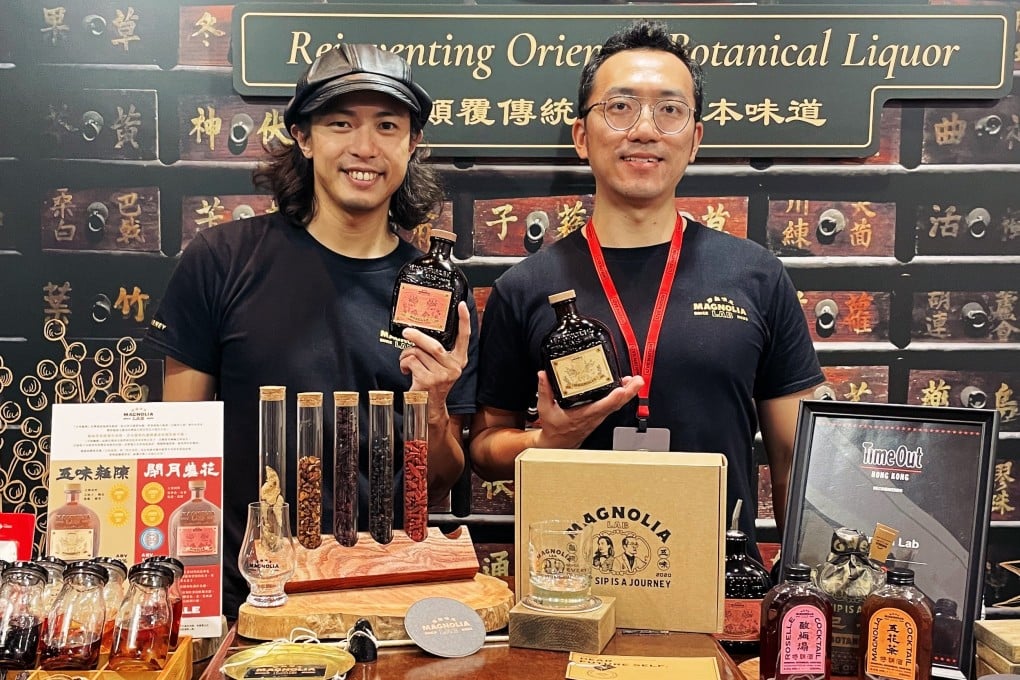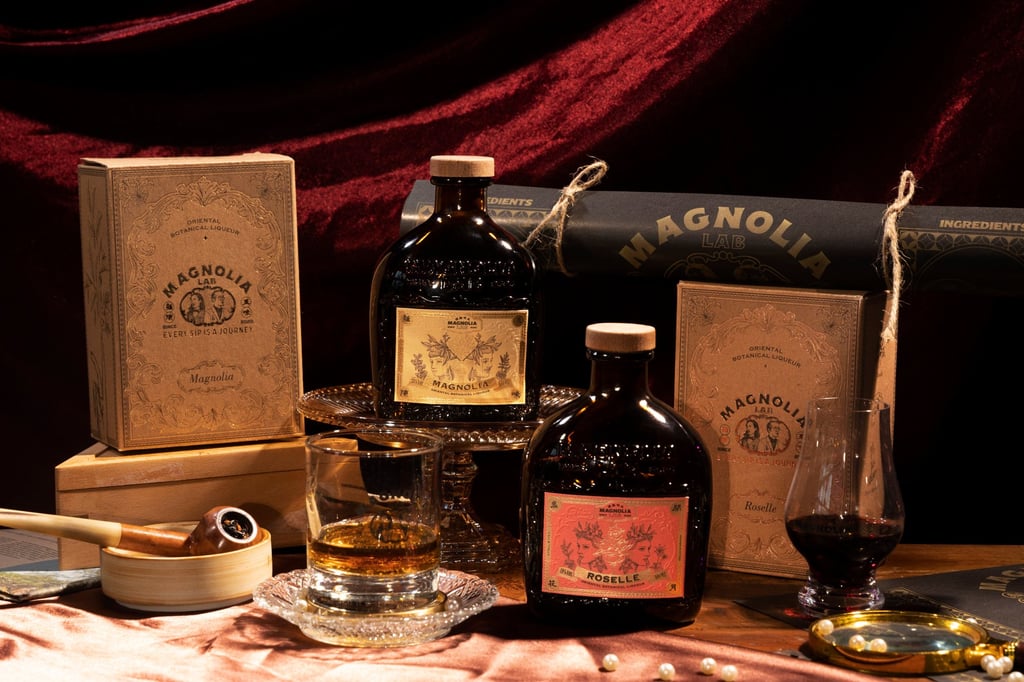
 i_need_contribute
i_need_contribute

Peek along the bottom shelves of Hong Kong supermarkets and grocery stores and you might see a category of booze once popular with both rich and poor: medicinal wines.
Yellow or rice wines infused with traditional Chinese medicine (TCM) ingredients were well loved among Hongkongers – they drank them “for health” – until the 1980s and ’90s.
Some of the better-known medicinal wine labels were Shi Quan Da Bu Jiu – “the ten complete wellness wine” – from mainland China, and Yomeishu – “wellness wine” in Japanese – from Japan. They even had television advertisements.
While these elixirs sank into obscurity in the decades that followed, bartender Dennis Mak and TCM practitioner James Ting are planning to revive the wines-for-wellness concept.

Dennis Mak and James Ting’s drinks brand Magnolia Lab currently offers two botanical liqueurs, Magnolia and Roselle. Photo: Magnolia Lab
In 2019, the duo created Magnolia Lab, a drinks brand that combines traditional herbal and medicinal wines with modern mixology.
“My partner and I started infusing wines in 2019,” says Mak. “Both of us feel that medicinal wines have a lot of tradition and historical value.”
Mak says that when he was growing up he would see his mother infusing wines at home.
“She had a bottle that she steeped for over 20 years,” he recalls. “It’s a shame that almost nobody practises or drinks these any more. The younger generation is quite skittish and avoidant when it comes to medicinal herbs and wines nowadays.”
He believes that, given that many of today’s spirits were once also used as medicine, now is the time to change how Chinese medicinal wines are perceived.
“Drinks like gin and tonic, Jägermeister, and a lot of herbal spirits were marketed as medicine once upon a time, too,” he says.
Tonic water contains quinine, a naturally occurring compound historically used to treat malaria, and gin was later added to make the bitterness of the quinine more palatable for drinkers. Jägermeister is a digestif that was initially marketed as a cough and digestive remedy before it became a popular cocktail ingredient.
Penfolds winery in Australia, meanwhile, was started by Dr Christopher Penfold to produce wines and make tonics to treat anaemia.
Chinese medicinal wines have a long history. The art of brewing medicinal wines and elixirs is woven into the fabric of Chinese culture, with the earliest mentions carved on ancient oracle bones from the Shang dynasty (1600BC-1046BC).
In the Ming dynasty (1368-1644), Chinese doctor Li Shizhen catalogued hundreds of recipes in a book, ensuring that these tonics have remained an integral part of Chinese wellness.
According to TCM practitioner Samuel To Ching-san, such wines are an effective tool in the realm of Chinese medicine.
“Alcohol acts as a conduit, directing medicinal effects and helping the medicine reach the affected area quickly,” he says.
“It also has a synergistic effect, dissolving the active components of herbs into the wine, enhancing the patient’s absorption efficiency.”
Magnolia Lab currently has two botanical liqueurs, named Magnolia and Roselle. Magnolia blends magnolia berries, aged tangerine peel, mulberries and sandalwood with Chinese liquor, resulting in a bittersweet, nutty elixir.
Advertisement
Roselle also has a bittersweet profile and is made with roselle, jujube, dong quai – Chinese angelica root – and dried ginger.
Mak says both of these concoctions go well with gin.
“When we were experimenting with the Chinese herbs to make our products, we were focused on making them flavour-forward,” Mak says. “We drink for flavour and not wellness any more, but James and I did make sure the ingredients did not clash and that they still followed TCM principles.”
For a recent pop-up event at Tai On Coffee and Tea Shop in Yau Ma Tei, Magnolia Lab expanded its footprint further by showcasing its liqueur in cocktails – something it has done with other venues in the past, such as bars and even on trams.
One cocktail it presented was a mixture of Roselle alongside gin, mulberry, goji berry and lemon.
The Magnolia liqueur featured in a concoction of gin, rice water, lavender and vanilla. We would not have guessed there were any TCM elements to this drink at all.
Mak hopes to revitalise the concept of Chinese medicinal wines through affinity.
“The elements that we use are familiar to Hong Kong people. Tangerine peel and dong quai are used a lot in cooking, and we smell sandalwood from incense,” he says.
“I hope that when people drink a cocktail in Hong Kong, they can sample the real flavours of Hong Kong as opposed to the flavours of Europe.”